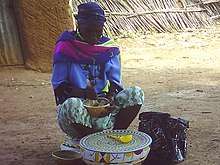Fura (food)
Fura are millet dough balls eaten in Nigeria, Niger and Ghana.[1][2][3]Fura da nono originates from the Fulani people of West Africa. It is a locally made drink prepared from a combination of fermented milk and ground millet grains. Sugar is added to the mixture to give it taste. It contains carbohydrate and fiber[4]
 A Fulani woman preparing fura da nono. | |
| Course | Snack |
|---|---|
| Place of origin | Ghana |
| Serving temperature | Cold |
| Main ingredients | Millet, Dry Ginger, Cloves, Dry Chilli Pepper. |
Steps in preparing Fura
Millet is first washed and the peels are removed. It is then dried. Dried ginger, cloves, and chilli pepper are added and ground. After it is in a powdered form, the mixture is placed in mortar and pounded whiles water is sprinkled gradually. It then forms a dough and then molded to desirable shapes. The balls are cooked for some minutes in boiling water. It is allowed to cool down, then pounded again and water is sprinkled whiles pounding till it gets soft. It is molded again and dusted with the millet flour.
References
- Telling Stories, Making Histories - Page 66 Certainly, the making of the classic dish, fura da nono (seasoned, boiled millet balls served with sour milk), represents such a blending of food resources and styles of cuisine. This suggests that a transfer of the cuisine of fura served with sour ...
- African Farming and Food Processing 2005 Fura is a staple food for both Fulanis and Hausas. Wherever there is a settlement of these tribes, fura, kindrimo and nono are marketed. A number 3f the dealers of fura are women between 25 to 35 years of age without formal education.
- www.ghanafoodnetwork.net http://www.ghanafoodnetwork.net/recipe/fura-fula-millet-smoothie/. Retrieved 2020-06-13. Missing or empty
|title=(help) - "Fura da Nono: Save yourself some money, learn how to make millet cereal". www.puls.ng.
Further reading
- Acceptability and effect of mixing ratios on the quality attributes of ‘Fura-de-Nono’: A Nigerian milk product [1]
- Changes in the acidity and lactic acid content of ‘Nono’, a Nigerian cultured milk product [2]
- Microbiological quality of locally fermented milk (nono) and fermented milk-cereal mixture (fura da nono) drink in Bauchi, a Nigerian city [3]
External Link
- Joseph, J. K.; Belewu, M. A.; Omotuyi, O. J. (1998-01-01). "Acceptability and effect of mixing ratios on the quality attributes of 'Fura-de-Nono': A Nigerian milk product". Food Quality and Preference. 9 (1): 1–4. doi:10.1016/S0950-3293(97)00011-6. ISSN 0950-3293.
- Atanda, O. O.; Ikenebomeh, M. J. (1988). "Changes in the acidity and lactic acid content of 'Nono', a Nigerian cultured milk product". Letters in Applied Microbiology. 6 (6): 137–138. doi:10.1111/j.1472-765X.1988.tb01233.x. ISSN 1472-765X.
- Adebesin, A. A.; Amusa, N. A.; Fagade, S. O. (2001-03-01). "Microbiological quality of locally fermented milk (nono) and fermented milk-cereal mixture (fura da nono) drink in Bauchi, a Nigerian city". Journal of Food Technology in Africa. 6 (3). doi:10.4314/jfta.v6i3.19295. hdl:1807/2964. ISSN 1028-6098.